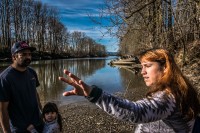Connecting with the Fishing Community
By Mary Ann Warner, Clean Water Community Organizer

Community organizing is not a desk job. One way that I organize is by teaming up with the houseless-rights advocacy group Right to Survive "R2S". R2S regularly hosts ‘riverwalks’ – outreach projects informing those living and fishing along the river about safe fishing practices and their rights to be in public spaces.
We came prepared with brochures in English and Spanish explaining the health risks associated with eating the resident fish in the Columbia River. High levels of toxics like mercury and PCBs make most resident fish too contaminated to eat yet many people, including the houseless, rely on these fish as a free source of food. We also brought basic supplies like food, blankets and hygiene packs to distribute.
Along the river we encountered a houseless couple and families fishing for supper.
At Kelly Point Park, located at the confluence of the Willamette and Columbia Rivers, there were two families fishing. A father-daughter fishing duo, originally from Los Angeles, assumed that all rivers were too polluted to eat from. The father was concerned about the pollution and wished it wasn’t harmful to his family’s health to eat what they catch locally.
Just a few yards away, another family was fishing for carp. They do eat their catch and were unaware of health advisories. In 2014, Riverkeeper took a carp caught nearby at Vancouver, Washington, to the lab. The results were stunning. This carp contained PCBs 30 times the Environmental Protection Agency (EPA) limit for unrestricted consumption, mercury 3.5 times the EPA limit, as well as flame retardants and other heavy metals. Oregon Health Authority recommends limiting the consumption of resident fish to just a few meals a month –if you’re willing to take necessary precautions to limit your exposure to toxics like removing the skin and fat.
At the James Glisan Boat Dock, a popular Columbia River recreation site in Portland, I met another family fishing. The initial language barrier made them hesitant to talk with me but when I switched to Spanish, they were relaxed and open to talking with me. The family of four was fishing for food and, like everyone else I spoke with that day, was unaware of fish advisories. I shared Columbia Riverkeeper’s fish toxics information with them and told them how to check fish advisories.
The takeaway from my day in the field is that the tradition of taking your son or daughter fishing persists. Less persistent are efforts by decisionmakers to clean up what’s contaminating the river in the first place. By talking with fisherman, I’m not just acting as an instructor on fish toxics, I’m connecting with future spokespeople and innovators for a clean river. The science on toxics polluting our rivers and fish is out there, the hurdle is making decisionmakers act.


